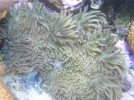little_fish
Reef pro
Scientific name - Heteractis crispa
Family – Stichodactylidae
Common name – Sebea, Leather Anemone
Max Size – 8 in (20 cm)
Range – Indo-Pacific
Min. Aquarium size – 30 gal (113 L)
Care Level – Difficult
Lighting - High
Temperament – Aggressive
Water flow – Moderate
Foods and feeding – It will get most of its energy from the light, but should be feed larger meaty foods like chopped fish, shrimp, scallops or clams.
Supplements - Iodine, Trace Elements
Aquarium suitability -
Reef compatibility – With caution, always the chance it might catch and eat a small fish.
Captive care – This is one the most difficult animals to keep in this hobby, and does not adjust to captive life well. They require extremely high lighting conditions, and pristine water. They are extremely sensitive to copper, nitrates and any swing in parameters can be fatal. Extreme caution should be taken with any anemone because when they die, the toxins they release can and will kill everything else in the aquarium. Any anemone should not be tempted in a tank less than a year old. When introduced to a tank an anemone will wander around until it finds a suitable place to live. It can sting other anemones, corals and fish so be sure it has plenty of space. This species of anemone will host clownfish.
Family – Stichodactylidae
Common name – Sebea, Leather Anemone
Max Size – 8 in (20 cm)
Range – Indo-Pacific
Min. Aquarium size – 30 gal (113 L)
Care Level – Difficult
Lighting - High
Temperament – Aggressive
Water flow – Moderate
Foods and feeding – It will get most of its energy from the light, but should be feed larger meaty foods like chopped fish, shrimp, scallops or clams.
Supplements - Iodine, Trace Elements
Aquarium suitability -
Reef compatibility – With caution, always the chance it might catch and eat a small fish.
Captive care – This is one the most difficult animals to keep in this hobby, and does not adjust to captive life well. They require extremely high lighting conditions, and pristine water. They are extremely sensitive to copper, nitrates and any swing in parameters can be fatal. Extreme caution should be taken with any anemone because when they die, the toxins they release can and will kill everything else in the aquarium. Any anemone should not be tempted in a tank less than a year old. When introduced to a tank an anemone will wander around until it finds a suitable place to live. It can sting other anemones, corals and fish so be sure it has plenty of space. This species of anemone will host clownfish.
Attachments
Last edited:

